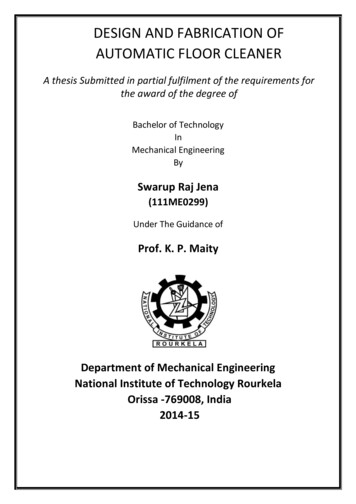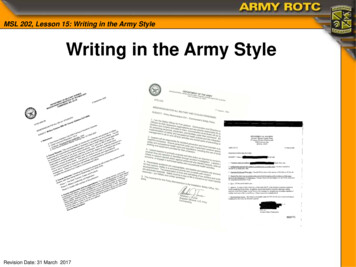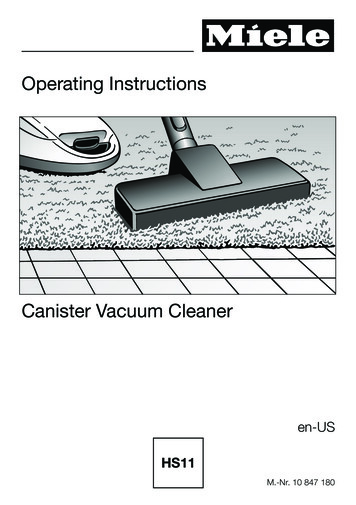
Transcription
Writing cleaner and morepowerful SAS code usingmacrosPatrick Breheny
Why Use Macros? Macros automatically generate SAS code Macros allow you to make more dynamic,complex, and generalizable SAS programs Macros can greatly reduce the effort required toread and write SAS Code
Outline1.Macro Basics2.Working with Macro Strings3.Getting More Out of Macros:a)Program Controlb)Interfacing with Data
The Compilation of SAS Programs SAS code is compiled and executed alternately insteps:– For example, a data step will be compiled and executed,then a procedure step will be compiled and executed IMPORTANT: Macros are resolved PRIOR to thecompilation and execution of the SAS code
SAS Compilation (cont’d) Code without Macros:SAS CompilationCodeProgramExecutionResults Code with outMacrosCompilationExecutionResults
Macro Basics The two basic elements of macro code are macrovariables and macros. In SAS code:– &name refers to a macro variable– %name refers to a macro Macro code consists of these two elements andtheir relationship to each other
Macro Variables Macro variables hold the value of text strings The easiest way to assign a value to a macrovariable is using %let:%let mac var Hello!!;%put The value of mac var is &mac var;The value of mac var is Hello!! Note that:– The value of a macro variable is referenced using &– Text without %’s or &’s (called constant text) is unaffected bymacro processing– Many SAS data step functions (like put) have macro analogs
A More Realistic Example Suppose we have separate data sets for each state, andwish to obtain county-level data for a given state withoutrewriting our code:SAS Code%let state IA;proc sort data survey &stateout sorted &state;by county;run;proc means data sorted &state;title "&state Results";by county;run;SAS Code aftermacro processing(invisible)proc sort data survey IAout sorted IA;by county;run;proc means data sorted IA;title “IA Results";by county;run;
Example with Multiple Variables The advantages of this approach are even more prominentwhen many parameters are present:%let state IA;%let sortvar Age;%let order ; *Note that macro variables can be empty;proc sort data survey &state out county &state;by county;run;proc means data county &state noprint;by county;output out county totals &state mean ;run;proc sort data county totals &state out sorted &state;by &order &sortvar;run;proc print data sorted &state;title "&state Results by &sortvar";run;
Macros To generate more complicated SAS code, wemust use macros, which are assigned using%macro and %mend statements:%macro reg;proc reg data dataset;model outcome age sex;run;%mend reg; A macro that has been assigned can then bereferenced with %name. The above regressionprocedure would be run with:%reg;
Macro Parameters The ability to pass parameters to macros makethem much more useful. For example, in regression, we often vary the setof predictor variables without changing the restof the code:%macro reg(predictors);proc reg data dataset;model outcome &predictors;run;%mend reg;%reg(age);%reg(sex);%reg(age sex);
Positional vs. Keyword Parameters One can specify macro parameters in two ways. Each approach has its advantages.PositionalKeyword%macro reg(predictors);proc reg data dataset;model outcome &predictors;run;%mend reg;%macro reg(predictors age sex);proc reg data dataset;model outcome &predictors;run;%mend reg;%reg(age sex);%reg;%reg(predictors age); Note that with keyword parameters, default settings can beassigned
Passing Multiple Parameters Usually, a combination of positional and keywordparameters makes the most sense (positional parametersmust come before keyword parameters):%macro county sort(sortvar, state IA, order );proc sort data survey &state out county &state;by county;run;proc means data county &state noprint;by county;output out county totals &state mean ;run;proc sort data county totals &state out sorted &state;by &order &sortvar;run;proc print data sorted &state;title "&state Results by &sortvar";run;%mend county sort;%county sort(age)%county sort(mortality, state FL, order descending)
Working with Macro Strings
The Implicit Handling of Strings Because macros and macro variables can only beassigned strings of text, string functions onmacro variables are handled implicitly:– Assignment: No quotes are necessary around the valueof a macro variable (%let mac var Hello;)– Concatenation: survey &state concatenates &state with“survey ” Most of the time, this is very convenient, but anytime you avoid giving explicit instructions,computers may do something other than whatyou want!
Concatenation The expression survey &state is unambiguous,but what about &state survey?%put survey &state;survey IA%put &state survey;WARNING: Apparent symbolic referenceSTATE SURVEY not resolved.&state survey A period is the signal in SAS to end a macrovariable name:%put &state. survey;IA survey
Concatenation (cont’d)Suppose we wished to import data from a filecalled “survey IA.xls”proc import datafile "H:\Data\survey &state.xls"out survey &statereplace;run;doesn’t work, butproc import datafile "H:\Data\survey &state.xls"out survey &statereplace;run;does
Double vs. Single Quotes Double quotes and single quotes affect macrovariables differently:proc import datafile ‘H:\Macro Workshop\survey &state.xls’out survey &statereplace;run;ERROR: Unable to import, fileH:\Macro Workshop\survey &state.xls does not exist. Note that macro variables inside single quotes are notresolved
SAS Characters with Special Meaning Suppose we wish to assign a macro variable astring with semicolons, commas, or quotes The macro function %str can be used, forexample, to pass an entire statement into amacro:%macro reg(predictors, options);proc reg data dataset;model outcome &predictors;&optionsrun;%mend reg;%reg(age sex, %str(mtest age, age - sex / canprint;));
Evaluating Numeric Strings Remember, macro variables are strings, notnumeric quantities:%let sum 1 1;%put ∑1 1 The function %eval can be used to obtain the(integer) numeric value of an expressioncontaining macro variables:%let total %eval(&sum);%put &total;2 Note: Floating point evaluations can be performed with%sysevalf
Getting More Out of Macros
Program Control The most powerful feature of macros is theirability to use conditional and iterative statements Data steps provide these same statements, buttheir effect is limited to a single data step Program control through macros can extendacross multiple data steps and procedures
Conditional Statements Conditional statements in macros work just likethose in data steps%if (&state eq IA) %then %put Iowa;%else %put Not Iowa;
%do Blocks Just as in data steps, compound statements aregrouped using %do and %end:%if (&state eq IA) %then%do;%put Iowa;%put Corn grows here;%end;%else %put Not Iowa;
Iterative Statements Iterative macro statements will also be familiar toanyone who has used the data step versions:%do i 1 %to 10;%put %eval(&i**2);%end; Note: %do %while and %do %until statements are alsoavailable
Macro Program Control Statements Macro program control statements are not validin open code They must be contained within macros
Macro “Arrays” Suppose we created a list of states:%let state1 AL;%let state2 AK;.%let state50 WY; If we were in the ith iteration of a loop, how wouldwe access the ith member of the list?%put &state&i;IA2
Macro “Arrays” (cont’d) Instead, we must force the macro processor tomake multiple passes over our code:&&state&i1st Pass&state22nd PassAK
Example Suppose we wish to create a report by state ofcounty rankings for a number of categories:%macro report;%do i 1 %to 50;%do j 1 %to 25;%county sort(&&var&j,state &&state&i,order descending);%end;%end;%mend report;%report;
Nesting Macro Calls As we just saw, it is often a good idea to nestmacro calls:%macro a;SAS code %b;SAS code %mend a; It is not a good idea to nest macro definitions:%macro a;SAS code %macro b;SAS code %mend b;SAS code %mend a;
Nesting Macro Calls (cont’d) When nesting macro calls, be careful to avoid variablecollisions:%macro print sums;%do i 1 %to 10;%put %sum(&i);%end;%mend;%macro sum(n);%let current sum 0;%do i 1 %to %eval(&n);%let current sum ¤t sum &i;%end;%eval(¤t sum)%mend; Scoping issues can be avoided by using %local to definemacro variables
Interfacing With Data Suppose we submitted the following code to SAS:data newdata;set survey IA;%let AgeSq Age**2;run; What would happen?
Interfacing With Data (cont’d) Answer:%put &AgeSq;Age**2 Because macros are resolved prior to theexecution of a data step, special routines arerequired for macros to communicate with data:– symput puts data into a macro– symget extracts data from a macro
How symput Works Calling the symput routine pauses execution of thedata step and writes a data value to a macrovariable Syntax:CALL SYMPUT(‘macro-variable’, data-variable); Both arguments to symput can be expressions IMPORTANT: You CANNOT access a macro variablewithin the same data step it is created
symputx: A Better symput CALL SYMPUTX is a variant of SYMPUT introducedin SAS 9 that has similar syntax, but handles theinput of numeric values better The following example illustrates the differencebetween the two commands:data null ;call symput('symput',5);call symputx('symputx',5);run;%put &symput ;%put &symputx ; 5 5
Example Suppose we want to compare two groups, but the preferredmethod depends on sample size:%macro compare(dsn, class, cutoff 20);data null ;set &dsn nobs nobs;call symputx('nobs',nobs);stop;run;%if (&nobs &cutoff) %then %do;proc npar1way data &dsn;class &class;run;%end;%else %do;proc ttest data &dsn;class &class;run;%end;%mend compare;%compare(mydata,age);
How symget works symget is much more straightforward:data-variable symget(‘macro-variable’)
Putting it all Together As a final example, suppose we want to create alist of indicator variables for the values of acategorical variable in a data set Note that if we don’t know the values inadvance, we have to approach the problem intwo steps1. Determine the new variables we are to create2. Create a data set in which we assign values to the newvariables
Putting it all Together (cont’d) We could approach the problem as follows:%macro make ind(dsn,cat);proc sort data &dsn out sorted;by &cat;run;data null ;set sorted end eof;by &cat;if first.&cat thendo;tot 1;call symputx("&cat.ind" compress(tot),compress(&cat));end;if eof then call symputx('tot',tot);run;(cont’d)
Putting it all Together (cont’d)(cont’d) data &dsn. ind;set &dsn;%do i 1 %to %eval(&tot);if (compress(&cat) eq "&&&cat.ind&i") then &&&cat.ind&i 1;else &&&cat.ind&i 0;%end;run;%mend make ind;
Putting it all Together (cont’d)%make ind(survey IA,city);proc print data survey IA yLinnAllamakeeStoryAmesCedar RapidsNew AlbinAmes1501801101206045255010010100NewAlbin0010
References The SAS Macro Language Reference:– df/index 912.html Carpenter, Art. 2004. Carpenter’s CompleteGuide to the SAS Macro Language, SecondEdition. Cary, NC: SAS Institute Inc.
SAS code is compiled and executed alternately in steps: – For example, a data step will be compiled and executed, then a procedure step will be compiled and executed IMPORTANT: Macros are resolved PRIOR to the compilation and execution of the SAS code. SAS Com











